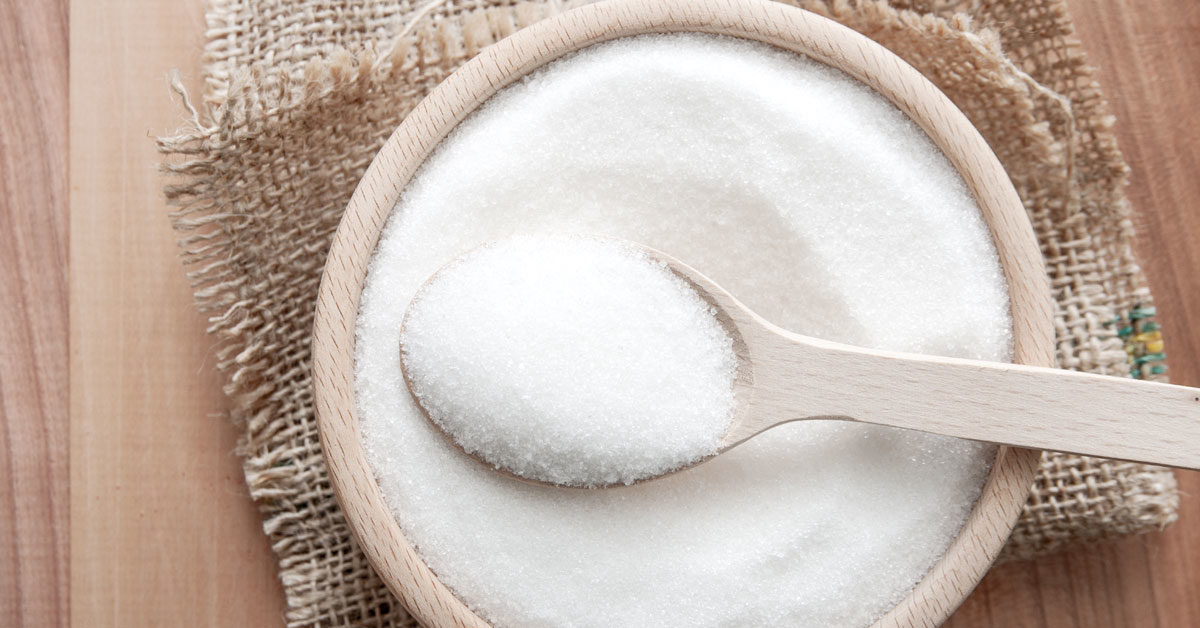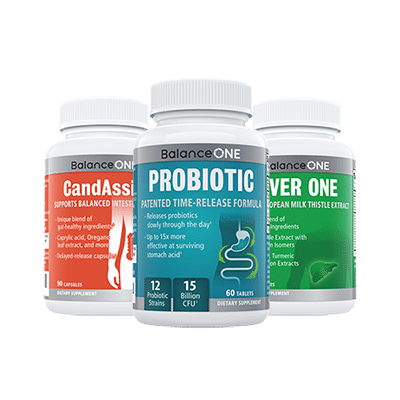Erythritol: A Healthy Alternative To Sugar

You don’t have to look far these days to find sugar-free treats, beverages, and candy. Unfortunately, not all sugar-free products are good! In recent years there’s been an upsurge in products containing harmful synthetic sweeteners such as aspartame.
Luckily, there are lots of natural sweeteners out there that are just fine for including in your Candida diet. In fact, many even have some health benefits!
Xylitol and stevia are already well-known natural sweeteners, with new ones such as monk fruit also on the rise. Let’s take a look at another new kid on the sweetener block: erythritol.
Table Of Contents
What is Erythritol?
Erythritol is a sugar alcohol that occurs naturally in certain fruits and some fermented foods. It can also be produced by fermenting glucose with yeast.
Erythritol’s selling point is that it’s 60-70 percent as sweet as table sugar – and yet it’s almost calorie-free. Best of all, it has none of the negative effects of sugar: it doesn’t affect blood sugar levels, doesn’t cause tooth decay, and doesn’t contribute to weight gain.
The reason for this is that the body cannot break erythritol down in the gut. This means you can’t obtain any calories from the erythritol that you eat. Most of the erythritol is simply passed out of the body as waste.
Erythritol is only partially absorbed into the bloodstream in the small intestine, with most being flushed out as urine. Because 90 percent of erythritol is absorbed into the bloodstream before it reaches the large intestine, it doesn’t tend to cause a laxative effect like other sugar alcohols. This is sometimes the case with xylitol and maltitol.
Erythritol is often used to sweeten products such as chewing gum, beverages and some baked goods. It’s also naturally present in grapes, pears, soy sauce and some wines.
Why is Erythritol Suitable On The Candida Diet?
Unlike artificial sweeteners, sugar alcohols occur naturally in certain fruits and vegetables. Sugar alcohols contain neither sugar nor alcohol: they just have a similar chemical structure.
Sugar alcohols take much longer to be broken down into glucose than sugar, and don’t require a lot of insulin. This means they don’t cause a spike in blood sugar levels like sucrose. Even better, they provide a sweet taste without the sugar, which can be very helpful for those craving a ‘sweet treat’ while on the Candida Diet.
6 Health Benefits of Erythritol
- It’s Sugar-Free
Because erythritol is a natural sweetener but contains no sugar, it doesn’t feed the yeast that contribute to Candida overgrowth. And it doesn’t promote tooth decay like sugar. - It’s An Antioxidant
Erythritol is also a proven antioxidant that can fight free radicals that cause cellular damage. It’s also been shown to protect blood vessels of diabetic rats against oxidative stress and prevent hardening of the arteries. - It’s Naturally Fermented
Erythritol can be made by fermenting the natural sugar found in corn. Look for an erythritol that is made from non-GMO corn. - It’s Great For Baking
Erythritol is heat stable up to 160 degrees C. This means those on the Candida Diet can still enjoy sweet baked goods! - It Has A Low-Glycemic Index
Because erythritol doesn’t raise plasma sugar or insulin levels in the way that sugar does, it’s a good option for those with diabetes. - It’s Satiating
Erythritol can slow down the passage of food from the stomach to the small intestine. This has been found to improve satiety. One study showed that adults of a healthy weight felt more satisfied after eating a meal containing erythritol than those who had a meal containing sucrose.
How Does Erythritol Compare To Other Sugar Alcohols?
The most well-known sugar alcohols include xylitol, sorbitol, mannitol and erythritol. Of these, erythritol is hailed as the easiest to digest. This is because most of erythritol is absorbed in the small intestine. The amount that does reach the large intestine isn’t enough to have any significant gastrointestinal effects. This makes it a suitable option for those with a sensitive digestive system, particularly those with Candida overgrowth or other digestive complaints..
Other sugar alcohols (such as xylitol) are not so well-absorbed, which means they pass through the digestive system in large amounts without being broken down. Once they reach the colon, they are occasionally known to cause bloating, diarrhea, and digestive upset.
Those who prefer a less intense sweetener may choose erythritol over other natural sweeteners like stevia, as erythritol is not very sweet on its own. Like monk fruit, erythritol has no aftertaste. However, this means erythritol is often added to other foods and beverages or combined with other sweeteners. Unfortunately, some commercial products may include a blend of erythritol and artificial sweeteners – so it pays to read the nutritional information first!
How To Use Erythritol
Being a soluble sugar alcohol, erythritol melts in high heat and doesn’t caramelize. This means it’s not suitable for baked goods that require a chewy texture. In some recipes, it may be necessary to use erythritol alongside other ingredients such as butter to help to retain moisture.
Erythritol can also be used in place of powdered sugar (such as for cake frosting), by adding it to a blender or food processor and pulsing into a fine powder. To thicken the texture, simply add a starch (such as cornstarch or arrowroot starch) to one cup of powdered sweetener. Some recipes also suggest using a pinch of guar gum and blending together.
NOTE: Sugar alcohols such as erythritol and xylitol don’t react with yeast, so they won’t help bread rise.
Where To Find Erythritol
It’s best to buy erythritol from a reputable health food store. Be sure to check that the erythritol product you’re buying is 100 percent pure: many companies add fillers or other ingredients to erythritol products to make it more palatable or to improve the texture. Some commercial products may even add artificial sweeteners such as aspartame. Check the ingredients first!
For more information on how switching to a low-sugar diet can improve your gut health and restore your energy levels, check out the Ultimate Candida Diet program. I co-wrote it with Dr Eric Wood, and designed it as a simple 5-step plan to get back to perfect health.

3-Month Candida Elimination Kit Start Your 3-month Candida Cleanse
This Candida Kit contains all the supplements recommended on the Candida Diet:
- LIVER ONE to process and remove the toxins created by Candida.
- CANDASSIST to inhibit and weaken the Candida colonies in your gut.
- PROBIOTIC to replace the Candida yeast with probiotic bacteria.
Plus... the CANDIDA DIET RECIPE BOOK with 50+ low-sugar recipes

Leave a Reply